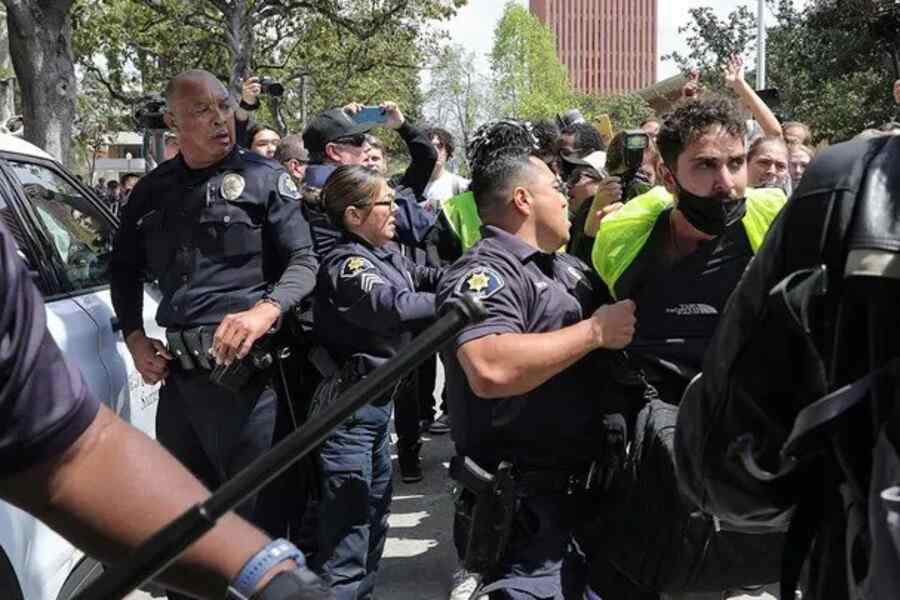
As campus protests swell across the United States, the unrest at Columbia University has become a focal point of a national debate over academic freedom and political activism. The demonstrations, which began as a response to the ongoing conflict in Gaza, have intensified calls for Columbia University President Minouche Shafik’s resignation, amid accusations that the university’s leadership has failed to adequately manage the crisis.
The unrest at Columbia reached a fever pitch when Republican House Speaker Mike Johnson, along with other political figures, openly demanded President Shafik’s resignation during a press conference disrupted by vocal protests. This incident highlighted the growing political pressure on university administrators to quell the disturbances that have now spread to several top-tier institutions including Harvard, the University of Texas at Austin, and more.
At Columbia, establishing a “Gaza solidarity encampment” at the heart of the campus has been the epicenter of the controversy. Protesters demanding the university cut ties with Israeli academic institutions and divest from companies associated with Israel have drawn national attention. The administration’s response, extending negotiations with protesters while moving classes to a hybrid model, reflects the complexities of navigating campus safety and upholding academic responsibilities during such crises.
The situation escalated following Speaker Johnson’s visit, where he aligned the campus unrest with broader concerns about antisemitism and the suppression of free speech. His statements have intensified the scrutiny of how universities are balancing the need for security with respect for student activism. At Columbia, the administration’s decision to potentially extend remote learning through final exams signifies the ongoing challenges in restoring normalcy.
Elsewhere, at the University of Texas at Austin, state troopers clad in riot gear were deployed to disperse protesters, signaling a stern response from local authorities. This action underscores the varied approaches taken by institutions across the country, navigating the fine line between maintaining order and respecting the right to protest.
Similarly, Harvard University has seen the rapid formation of protest encampments, with students preparing to withstand the elements to voice their solidarity with Gaza. These protests across various campuses share common themes of solidarity with Palestinian causes and criticism of Israeli policies. Yet, they also expose the deep divisions within university communities over these issues.
The reactions to these protests extend beyond campuses. Texas Governor Greg Abbott’s condemnation of the protests as antisemitic reflects a broader political context in which these university protests are unfolding. Such statements influence public perception and suggest potential legislative responses that could impact how protests are managed at state-funded institutions.
At Columbia, the tensions are particularly pronounced due to the university’s prominence and its location in New York City—a hub of both academic and international diplomacy. The administration’s extended negotiations with student protesters have been a delicate dance of trying to address activist demands while ensuring the continuity of academic programs.
The national attention has not only affected those directly involved but also influenced public opinion and policy discussions about academic freedom, protest rights, and the role of universities in addressing international conflicts. The White House has remarked on the protests, emphasizing respect for peaceful protest as a fundamental American value, yet also acknowledging the complex emotions these protests have stirred.
These campus protests are emblematic of a larger movement that has seen students across the country engaging in similar demonstrations, indicating a significant shift in how current global events are influencing student activism. The widespread nature of these protests has prompted a reevaluation of university policies on campus protests and political activism.
As these protests continue, the role of university leaders becomes increasingly scrutinized. President Shafik’s leadership is under a microscope, with significant pressure to both uphold free speech and ensure campus safety. The potential resignation of a university president over protest management would set a significant precedent in higher education governance.
Moreover, the involvement of local and national law enforcement in campus protests raises questions about the appropriate level of response to student demonstrations. The use of riot gear and the arrest of protesters at several universities have been contentious, with critics arguing that such measures are disproportionate and could stifle free expression.
The dialogue around these protests also includes the voices of those who feel marginalized or threatened by the demonstrations. Jewish students and faculty at Columbia and other universities have expressed concerns for their safety and the overall campus climate, which has been charged with political and emotional tensions.
This unfolding situation at Columbia and beyond serves as a case study of the challenges facing modern universities when student activism intersects with global political issues. The decisions made by university administrations in response to these protests will likely influence future approaches to handling similar situations, not just at Columbia but across all institutions of higher learning in the U.S.
As the academic year progresses, the resolution of these protests and the responses from university leaders will be critical in shaping the landscape of higher education. The outcome will not only determine the immediate future of President Shafik and Columbia University but also set the tone for how American universities address complex global issues that resonate deeply with their student bodies.
As these protests stretch into more prolonged and widespread movements, they challenge the traditional roles and responsibilities of academic institutions in society. How these challenges are met will resonate far beyond the individual campuses currently embroiled in these debates, potentially reshaping the very nature of higher education in America.








